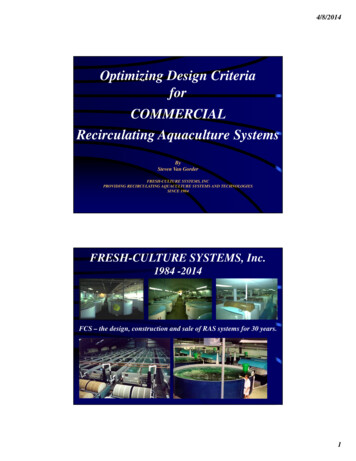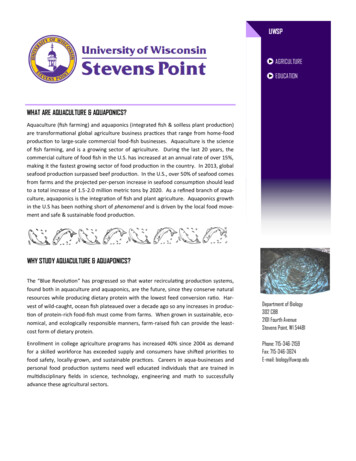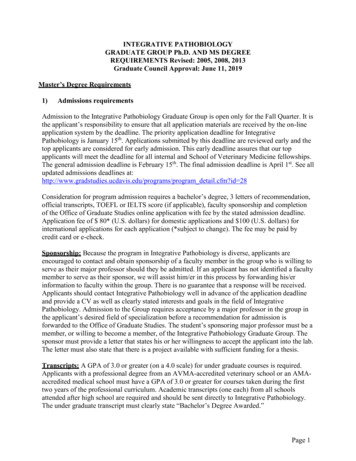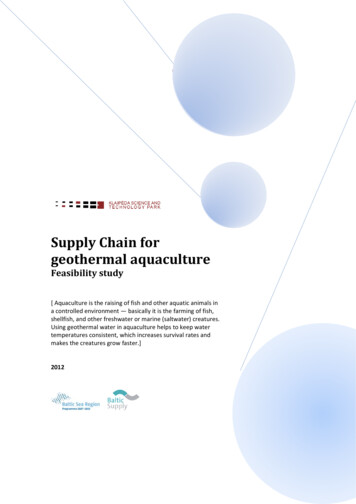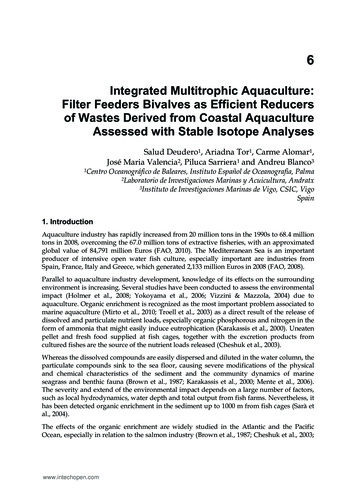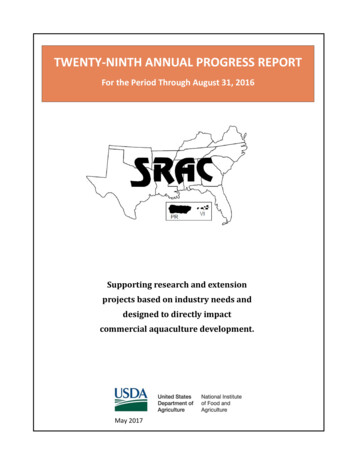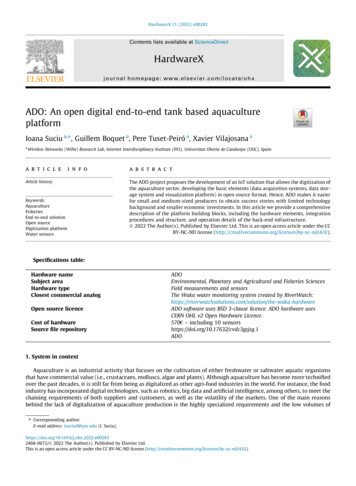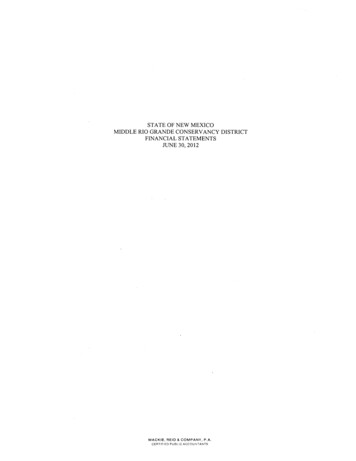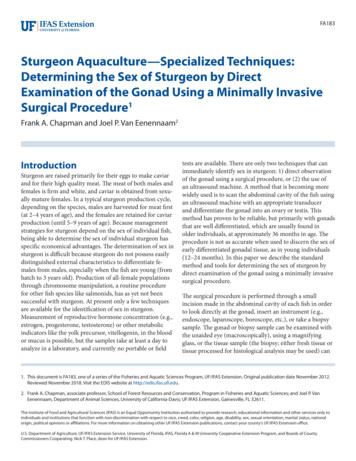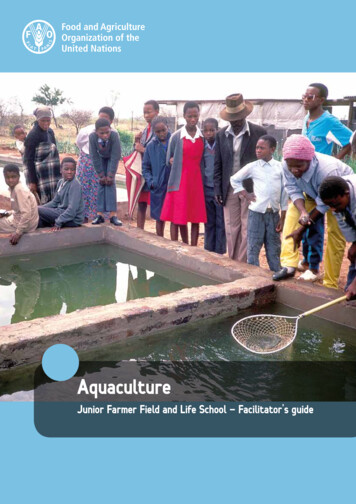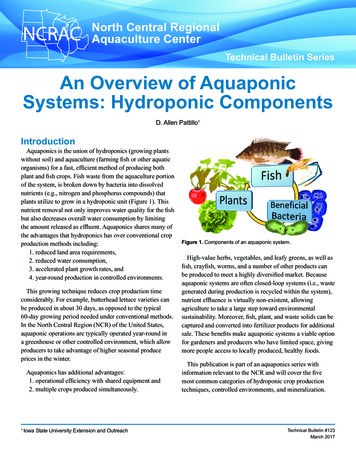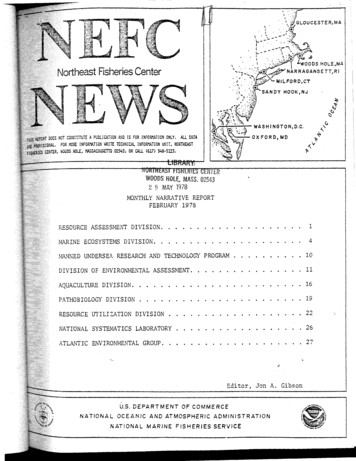
Transcription
SORT DOES NOT COllSTITUIT A PUBUCATIO. AND IS FOR INFORMAiIO ONLY. All DATAFOR IA.ORE INFORMATION WRITE TECHNICAL niFORl"Jff ION Utm. NORTHEAST-. . 111:,.muruFs CENTER, WOODS HOLE . MASSAQIUSETTS 02543; OR CALL 617 548-5123.MONTHLY NARRATIVE REPORTFEBRUARY 1978RESOURCE ASSESSMENT DIVISION.1M.i\RINE ECOSYSTEMS DIVISION . .4M.t\NNED UNDERSEA RESEARCH AND TECHNOLOGY PROGRAM . 10DIVISION OF ENVIR01'.'i'lENTAL ASSESSMENT. .11AQUACULTURE DIVISION.16PATHOBIOLOGY DIVISION. 19 22RESOURCE UTILIZATION DIVISION .NATIONALSYSTE i TICS. 26LABORATORY . 27ATLANTIC EN-VIRONMENTAL GROUP. . . .Editor, Jon A. GibsonU.S. DEPARTMENT OF COMMERCENATIONAL OCEANIC AND ATMOSPHERIC ADMINISTRATIONNATIONAL MARINE FISHERIES SERVICE
RESOURCE ASSESSMENT DIVISIONResource Surveys InvestigationThe four-part surf clam and ocean quahog survey was completed inFebruary aboard the Delaware II. Henry Jensen (Chief Seientist) and AndyThoms (Watch Chief) participated during the entire cruise. Because of theirefforts and.the cooperation of the crew of the Delaware II, this cruise wasone of the most successful in the recent series. The cruise began on 4January and ended on 11 February; in all, 351 dredge tows were made.The first part of the Atlantic mackerel, Atlantic herring, and squidssurvey on the Soviet R/V Argus (Bill Overholtz, Chief Scientist) was completedon 13 February. The second part of the cruise (John Messersmith, ChiefScientist) began on 14 February and is scheduled to end in early March. Datacollection during the first part included sampling of special stations and a24-hr study of the feeding habits of squids. In addition, 25 trawl stationswere sampled as part of the Atlantic mackerel and Atlantic herring survey.John Nicolas, working with Ollie Brazier of the Woods Hole OceanographicInstitution, completed for the College of the Atlantic a compilation of whaleobservations made during 1977 bottom trawl survey cruises. Corrections to thefinal audits on the 1977 fall bottom trawl survey data were made by LindaDespres. Malcolm Silverman and Chuck Byrne completed auditing and correctinghistorical cruise tapes (primarily inshore cruises) brought to Woods Hole fromSandy Hook. Many of these cruises have been put into tape storage and one,two, and four-card listings are currently being generated.Age and Growth InvestigationMr. Joe Hunt from St. Andrews Laboratory in Canada visited the WoodsHole Laboratory to review the aging -0f Atlantic herring with Louise Dery andFred Nichy. Canadian and American age samples were examined to substantiatethe Canadian aging of older fish, mainly the 1970 year class.Judy Penttila and Fred Nichy completed reviewing the proposal for acontract to develop programs for an automatic aging system. A delay hasoccurred in preparing age samples for the proposal because of the loss indelivery of a new type of laminate plastic.Vi Gifford and Kris Kantola assisted four, 6th-grade students in aspecial out-of-school program in removing age structures from fish anddemonstrated how these structures are aged.Age samples completed during the month were: (1) redfish (from Albatross!Y Cruise No. 77-07); (2) pollack (from commercial samples from the second,third, and fourth quarters of 1977); (3) red hake (from Albatross IV CruiseNo. 71-01); and (4) scallops (from commercial samples of the F/V Kalina,. theF/V Sharon, and the F/V Noreen).-1-
"§p.ndy Hook InvestigationEstimates of fecundity were completed for 147 summer flounder,paralichthys dentatus, .previously collected. An ecological study of seasonalhan es in the relationships of benthic f inf ish fauna in Sandy Hook and ari an Bays was initiated based on analysis of data collected from June 1974through November 1976.Length-weight relationships were calculated for the major species offish observed in the New Jersey party and charter boat fishery. Calculationof the relationships was made necessary as some of the interview datacontained a high proportion of weights of gutted fish which causedunderestimation of weights for some species. Revision of the computer programto incorporate a gutted-weight-to-whole-weight conversion routine wasinitiated .Fishery Analysis InvestigationRalph Mayo and Bill Callahan spent the entire month gathering andsummarizing data for Joe Mueller of the Regional Office. Harold Foster begananalyses on the Atlantic cod stocks, relieving Paul Wood of the responsibilityfor that species. Paul Wood began preparatory work for a FMP on sea scallops;he.and Fred Serchuk also attended on 28 February a meeting in Woods Hole onthe management plan, with representatives of the New England and Mid-AtlanticCouncils present. Fred also continued his work on Atlantic cod and red crabs.Steve Murawski began initial analyses of population indices for surf clams inthe Mid-Atlantic from the latest cruise.Many in the group attended meetings. Fred Serchuk attended thefollowing meetings: NERFMC Groundfish Oversight Committee on 1978 GroundfishManagement Plan in conjunction with recreational industry advisors - 3February, Peabody MA; public hearing on 1978 Groundfish Management Plan - 3February, Brunswick, ME; Gloucester Fishermen's Association on GroundfishManagement Plan - 4 February, Gloucester, MA; NERFMC Groundfish OversightCommittee on 1978 Groundfish Management Plan - 6 February, Peabody, MA; publichearing on 1978 Groundfish Management Plan - 6 February, Gloucester, MA;NERFMC monthly meeting - 14 February, Peabody, MA; and IYABA monthly meeting 15 February, Sandy Hook, NJ. Judy Brennan gave a seminar to a group offaculty and students of the University of Connecticut at Wolcott, CT, on 21February. The topics were: the Schaefer model for estimating the MSY for thetotal biomass; and the uses of linear programming in fisheries work. She alsoattended negotiations with Cuban delegates concerning increasing the quotas ontheir by-catch species, 27-28 February, Washington, DC, and completed theupdate of the Report to Congress on Overfishing since 1972. Steve Murawskipresented a paper at the Northeast Fish and Wildlife Conference at WhiteSilver Springs, WVA.Fishery Assessment InvestigationSteve Clark attended a meeting of the Northern Shrimp ScientificCommittee on 21 February in Portsmouth, NH, at which time an assessment wasprepared concerning the impact of reopening the shrimp fishery in the Gulf of-2-
Maine. Steve, as Chairman of the Committee, presented the assessment resultsto the Northern Shrimp Sub-board of the ASMFC on 22 February. Based largelyon the advice of the Committee, the Sub-board voted against reopening thefishery in 1978.·On 28 February, Steve presented a paper at the Northeast Fish andWildlife Conference held in White Sulphur Springs, WVA, entitled: "TheApplication of Bottom Trawl Survey Data to Fish Stock Assessments."Emma Henderson has been assembling data for updating red hake and summerflounder assessments and developing some computer programs to aid in proratingsampling data.Bill Overholtz was aboard the USSR R/V Argus during the first part ofthe Atlantic mackerel and squid bottom trawl survey from 27 January to 13February in the Georges Bank area. In addition, he has been calculatingnumbers-at-age catch data for haddock for use in virtual population analysis,processing commercial weighout reports for ADP, and preparing an Atlanticmackerel report for the USA Research Report to ICNAF.Brian Hayden completed work on some historical Atlantic mackerel catchdata and participated in the second part of the R/V Argus survey from 14February to 2 March. Brian also received a 700-hr extention. on his part-timeappointment.Thurston Burns and Frank Almeida were aboard the FRG R/V Anton Dohrn forthe first part of the spring juvenile Atlantic herring survey which began on28 February. Thurston has also assumed responsibility for processing thecommercial weighout reports for ADP.Frank Almeida completed a report on von Bertalanffy growth equations forthe silver hake stocks and has continued to assemble silver hake and red hakedata for assessments. Frank has assumed responsibility for processing the NewEngland industrial fishery statistics, has completed the final computer runsfor the 1977 data, and has begun work on the 1978 samples. On 22 February,Frank attended a meeting of the New England Fishery Management Council's S&SCommittee held in Boston to discuss data needs and progress on the silver hakeFMP .Emory Anderson gave a lecture on assessments on 15 February at the WoodsHole Laboratory to a class in fishery economics from the MassachusettsMaritime Academy. Emory attended the meeting of the ICES Mackerel WorkingGroup held in Charlottenlund, Denmark, during 20-24 February, and then was inGdynia, Poland, at the Sea Fisheres Institute from 27 February to 6 Marchworking with Andrzej Paciorkowski on a joint Atlantic mackerel paper to bepresented at the ICES/FAO/ICNAF Pelagic Fish Stock Symposium to be held inJuly in Scotland.Fishery Systems InvestigationAssessment activity continued during February 1978. In addition, Langeattended the 13-18 February ICNAF STACRES meeting held in Havana, Cuba, todiscuss management recommendations for the Illex fishery in ICNAF Subareas 3and 4. Canada requested this meeting to reconsider previous mattagementschemes in light of the greatly exceeded 1977 recommended TAC in this area(25,000 ton recommended TAC vs. 80,000 ton catch). The results of the meetingwere to recommend a TAC of 100,000 - 120,000 tons to be divided between-3-
Subareas 3 and 4. This changes the previous viewpoint of managing the entirefishery from Subareas 3 through 5 and Statistical Area 6 as a single stock,an overall TAC, and then dividing catches among all four areas. Theossibility of managing this species by catch-per-effort restrictions, rather han catch limitations, was also discussed and referred to the Aprilassessment meeting. A recommendation for standardized data collection wasalso made, including length-frequency sampling by sex and 0.5-cm intervals.Michael Sissenwine represented the NEFC at a public hearing on theGroundfish Management Plan held in New Bedford on 1 February. He alsoattended the National Marine Fisheries Service Ecosystem Modeling Workshop inSeattle, WA, during 6-10 February and a meeting of the Steering Committee ofthe Fisheries and Climatology Workshop on 24 February at the University ofRhode Island. The full workshop will be held 29-31 March in Rhode Island.During 25-28 February in New York City, he participated in a working grouppreparing further cross-examination for electrical power generating utilitiesin the Hudson River Adjuditory Hearing Case.ManuscriptsAnderson, E. D., and F. p. Almeida. 1978. Assessment of theGulf of Maine silver hake stock. NMFS, NEFC, Woods HoleLab. Ref. No. 78-10 (mimeo.).Almeida, F. P. 1978. Determination of the van Bertalanffy growthequation for the southern New England - Middle Atlantic,Georges Bank, and Gulf of Maine stocks of silver hake.NMFS, NEFC, Woods Hole Lab. Ref. No. 78-13 (mimeo.).Serchuk, F. M., P. w. Wood, and B. E. Brown. 1978. Summaryand review of the 1978 assessment and status of the GeorgesBank cod stocks. NMFS, NEFC, Woods Hole Lab. Ref. No. 78-11.MARINE ECOSYSTEMS DIVISIONEcosystem Dynamics InvestigationEd Cohen and Marv Grosslein with inputs from Mike Sissenwine and FrankSteimle completed a status report on energy flow studies by the Center (WoodsHole Laboratory Reference No. 78-14). Ed presented the report at theecosystem modeling workshop in Seattle during 7-9 February. Comparisons ofthe energy budgets for Georges Bank and the North Sea indicated that GeorgesBank was much more productive at all levels of the food web. The productionestimates for Georges Bank are preliminary, but the consistently higher valuesfor all levels suggest that the difference is real. Further study isnecessary to evaluate the degree of differences between Georges Bank and theNorth Sea.Ed Cohen and Marv Grosslein assisted Dr. Vinogradova and dtherscientists from the USSR R/V Argus in preparing for their cruises. Thisinvolved making arrangements with Dr. Guillard's group at WHOI forphytoplankton cultures, obtaining glassware and chemicals for culturing the-4-
lankton at sea, providing plastic bottles for nutrient samples, andreliminary coordination of the productivity studies to be done on Argus in arch and April with NMFS and Brookhaven National Laboratory scientists.Mike Pennington and Marv Grosslein completed a manuscript on accuracy ofabundance indices based on stratified-random trawl surveys, and Mike presentedthe paper at the American Fisheries Society Meeting (Northeast Division) inWest Virginia during 26 February - 1 March 1978. Theoretical and empiricalanalyses suggest that a significant part of the variability associated withsurvey catch-per-haul abundance indices may simply reflect variabilityinherent in the distances towed on standard 0.5-hr hauls. Preliminaryestimates suggest that if towing speed and distance over the bottom could beheld constant on each haul, the gain in precision might be equivalent todoubling the number of hauls. For example, confidence limits around an indexfrom a single survey on Georges Bank might decrease from 50% to 30%.Smaller improvements in precision may be possible by post-stratification ofthe survey data according to time of day; more important, anomalies innight/day ratios of catch may prove to be useful in detecting changes incatchability coefficients which can induce bias in indices for any one survey.Recruitment Processes GroupIn the Recruitment Processes Group analysis of the ex sting larvalherring data base continued for an up-to-date assessment of the larvalAtlantic herring time series, 1968-77. Fifty-six surveys are included; 10surveys have been processed for herring larvae since the first of the year bythe Woods Hole, Narragansett, and Sandy Hook Laboratories. Our bestquantitative estimate of the 1977 larval herring production for the GeorgesBank-Nantucket Shoals area is 80.3 x io 1 1 larvae, which is intermediate insize between the record low of 1976 (1.11 x 10 11 ) and 1971 (193 x 10 11 ).Refer to the October monthly NEFC report for a complete listing of the 1971-76larval herring production estimates.The February larval herring survey (Albatross IV Cruise No. 78-02) leftWoods Hole 14 February with Georges Bolz as Chief Sci en tis t and coop-studentsElizabeth Stein, Dana Temple, and Peter Hamer on their first survey. The firstleg of the standard survey ended 22 February and then Greg Lough, CabellDavis, and Hal Merry boarded Albatross IV to conduct special vertical samplingwith MOCNESS until 8 March. Observations from the first leg indicated atypical February larval herring distribution with a few larvae per haul oncentral Georges Bank and Nantucket Shoals.Benthic Dvnamics InvestigationEvaluation and analysis of the quantitative data pertaining to the NewEngland macrobenthic invertebrate fauna were continued; a report on thedistribution of nemertines was completed. Progress also was made on updatingselected portions of this macrobenthic data set and in assembling data an'achecking records in relation to the distribution of bivalve mollusks,.Food habits analysis of the 1969-1972 Pleuronectiformes data base is inProgress. All the data have now been keypunched and are being audited. Thefood habits of juvenile haddock, 1956-1976, have been tabulated for each of-5-
ecological areas. Albatross IV Cruise No. 78-02, a fish food habits andng chronology study, was cancelled because of bad weather. The cruisebe rescheduled later in the year.Investi ationPreparation for and participation in cruises occupied much of February.Kirschner prepared drogues for use on the MOCNESS cruise on Albatross IVGil Dering installed the thermosalinograph for the same cruise.While Albatross Y was in port we tested the new transducer installationuse during the current-meter recovery cruise in March. The STDerature sensor was also calibrated and the current-meter hardwarechased .With the beginning of the 1978 series of MAR.MAP cruises, we suppliedkin bottles, thermometers, and other equipment to Delaware II. Tim CainRay Cloutier sailed as oceanographers on the first leg of the cruise; Annerldns and Dan Patanjo on the second leg.Meanwhile, Sam Nickerson has continued plotting XBT data, Steve Ramp hasen looking at current-meter data, Anne Dorkins, and Tim Cain have keptucing the backlog of salinity samples, and Gil Dering has been assemblingcurrent-meter test equipment. Dan Patanjo has been organizing a cruiseort data inventory, Ray Cloutier has been plotting horizontal charts ofal herring cruise distributions, and Red Wright, Ron Schlitz, and Stevehave been working on their AGU papers. Bob Pawlowski worked on hisuscripts.while not away at NOS training sessions, and Kirschner producedJanuary SOOP report.Investi ationStudies of the influence of prey densities of Q.01-3.0/ml on growth,:rvival, and feeding of larval Atlantic cod from hatching to metamorphosistinued into their 5th week of a 2-mo study. Winter flounder eggs andrvae are being analyzed for DNA, RNA, and protein content as part of aoperative study with EPA on the effects of petroleum hydrocarbons. Studiesthe influence of prey densities on larval cod DNA, RNA, and proteintent, and measurements of the excretion rates of nitrogen containingounds were continued.Adult haddock have been obtained to serve as spawning stock for studiescompetition between cod and haddock larvae with regard to feeding andowth experiments with both species held in the same tanks.o lankton Investi ationWe have reached the halfway point in our third ichthyoplankton survey ofs fiscal year. Weather has been favorable and progress to date is ahead ofedule Plankton volumes are light in samples taken throughout the M'1ddlentic Bight and southwest Georges Bank. As expected, the sanJ lance,d tes sp., dominates the ichthyoplankton north of Chesapeake Bay. On thes of preliminary observations, however, sand lance larvae are not asdant as last year. Staff biologists were excited over the capture of a-6-
oarfish, Regalecus sp., off the outer banks of North Carolina. Alsoking of the herring, this rare oceanic species ranges worldwide inern hemisphere. It's our first specimen.eline maps have been prepared for the BLM contract and we begandistributions of fish eggs and larvae collected on semiannual surveysiddle Atlantic Bight. The data will show that spawning activity isnse during the fall surveys, conducted in October and November, thanspring surveys, which are usually conducted in March. For the next fewwe will continue to concentrate on ADP aspects of the historical dataNyron Silverman is performing quality audits on data entered into thet Rosenberg is transferring historical ichthyoplankton data andenvironmental observations to OPSC.AN so that the data can be enteredInvesti ationSelected stations from Albatross IV Cruise No. 75-12 and Argus Cruise1-01 were sorted for herring larvae and the data summaries sent to GregInformation on the relative abundance (No./100 m3 ) of euphausiids onBank during the spring and fall of 1971-75 was provided for aication sent to Woods Hole. A high priority goal of the group was11shed with the completion of samples from Albatross IV Cruise No. 71' on Georges Bank. This provides a set of zooplankton data for 1971or spring and fall for this area. This task was initiated in the fall ofinvolves approximately 400 samples. A careful adherence to qualityand sorting protocol was maintained despite changing personnel andtasks. The 1971-1975 spring-fall bottom trawl survey temperature (XBT)e being summarized for inclusion in a study of zooplankton distributioncollections made on these surveys.statistics Unit!. ata processing efforts were divided between the BLM contract data forlook and ichthyoplankton data from the Polish Sorting Center. Somewas made on both fronts despite adverse climatic conditions.ne Heyerdahl, Kay Paine, Ed Handy, and Herb Stern met with all of thesett Laboratory investigation chiefs on 2 February to discuss the dataing problems associated with the forthcoming termination of thet with the University of Rhode Island for the development of the MARMAPtion System (MIS).everal students have joined the Biostatistics Unit since the first ofLinda Cummings (Suffolk University), Eric Stirrup (Roger Williams), and Gary Johnson (University of Rhode Island) are assisting in dataquality control, and data retrieval. Mark Nally (University of Rhode' a computer programmer, is studying the programs in the MIS to assiststatistics Unit in the operation of the system.nneth Sherman met with several members of the Biostatistics Unit andthyoplankton Investigation on 3 February at the Newark airport to-7-
discussdata processing responsibilities within Survey I. It was resolvedthat sandy Hook would fulfill all keypunching requirements for Survey I datadata entry into the MIS will be performed at Narragansett. Qualitybe shared within the division.Predators InvestigationTag returns were received from four sharks during February. Two weremale blue sharks tagged off Shinnecock and recaptured by Korean longliners in1976· The first was at liberty 1,386 days and was taken 260 mi ESE of CapeHatteras. The second was out 809 days and traveled east to within 600 mi ofthe Azores. A third female blue shark tagged off Montauk, NY, was recaptured441 days and 116 mi to the southeast. A female nurse shark was "hand caught"by divers after 1,103 days at liberty 10 mi south of the tagging location.This recapture method is discouraged by our program.The contract for printing the biannual shark tagging newsletter wasawarded by the GPO, Boston. Delivery is expected in early March.Preparations were started for a 19-day Wieczno cruise in March to longline forapex predators. John Hoenig completed his term of employment.Meetings, Talks, Visitors, PublicityGene Heyerdahl, Herb Stern, Ed Handy, Merton Ingham, Kay Paine, RobertMarak, Jack Jessi, and Kenneth Sherman met on 2 February at the NarragansettLaboratory to discuss ADP problems.Kenneth Sherman, Donna Busch, and David Bearse traveled to Newark on 3February to develop data processing schedules with the staff of the SandyHook Laboratory.Geoffrey Laurence and Kenneth Sherman went to a NMfS Ecosystem ModelingWorkshop at Seattle, WA, during 7-10 February. Geoff delivered a presentationon empirical and s to ch as tic modeling of larval fish survival and Ken describedresults of our ecosystem studies.On 15 February an IYABA meeting was held at Sandy Hook, NJ. KennethSherman, Geoffrey Laurence, Donna Busch, Jan O'Reilley, Joel Bodamm.er, FredThurberg, Fred Serchuk, and Judy Krzynowek attended.On 22 February, Vyacheslav v. Konchin, visiting scientist from theSoviet Union, gave the Narragansett Laboratory staff a slide show of somehistorical sites in Russia.Also on 22 February, Redwood Wright, George Kelly, Carolyn Griswold,Kenneth Sherman, Donna Busch, Merton Ingham, Lockwood Chamberlin, ReedArmstrong, Marvin Boussou (RO), and Don Phelps (EPA), met at the NarragansettLaboratory to discuss the approach to a joint NMFS/EPA plan for dealing withassessment studies for spills of oil and other toxic substances.On 23 February, Kenneth Sherman and Carolyn Griswold attended a meetingat the Regional Office, Gloucester, to discuss the development by ERL of aRegional Response Plan for oil spills.Dr. Red Wright represented the NEFC at a conference on lorrg-termecological monitoring at MBL, and attended an NEFC/EPA meeting in Narragansetton oil spill response plans. George Kelly also took part in both meetings.Dr. Wigley conferred with members of the benthic invertebrate research-8-
oup at the Sandy Hook Laboratory. Principal topic of discussion was theantitative benthic sampling conducted in the Middle Atlantic Bight.Rich Langton was an invited speaker at the "Cieme Colloque Annuel" ativersite Laval, Quebec. He presented a lecture entitled, "The Argo Merchant1 Spill," which was one of six talks dealing with man's impact on the 1vironment Ed Cohen, Marv Grosslein, Mike Sissenwine, and Frank Steimle completed atatus report on energy flow studies by the Center (Woods Hole Lab. Ref. No.8 14) and Ed presented the report at the ecosystem modeling workshop ineattle, 7-9 February.Mike Pennington and Marv Grosslein completed a manuscript on accuracy of bundance indices based on stratified-random trawl surveys, and Mike presentedthe paper a,t the American Fisheries Society Meeting (Northeast Division) inwest Virginia, 26 February - 1 March 1978.Adam Benovic,currently visiting a number of US laboratories on a NATOfellowship from the Marine Biological Institut, Dubrovnik, Yugoslavia, talkedwith Greg Lough, 14 February, regarding plankton activities at the NEFC.Marv Grosslein attended the S&S Committee meeting for the New Englandcouncil on 22 February. Recommendations for continued herring tagging studiesby the Center were discussed among other items.PublicationsColton, J.B., Jr., w . C. Smith, A . w. Kendall, Jr., p. L.Berrien, and M. p. Fahay. Principal spawning areas andtimes of marine fishes, Cape Sable to Cape Hatteras.Fish. Bull. (S)Langton, R., and R. Brodeur . Occurrence of a rare adult mudshrimp, Naushonia crangonoides (Kingsley, 1897) from theChesapeake Bay Region. Crustaceana (A)Langton, R. W. , J. E. Winter, and 0. A. Ro els. 19 77. Theeffect of ration size on the growth and growth efficiencyof the bivalve mollusk Tapes japonica. Aquaculture 12(1977):283-292. (P)Laurence, G. Comparative growth, respiration, and delayedfeeding abilities of larval cod and haddock. Mar. Biol. (A)Griswold, c., and K. Sherman. 1978. Offshore oil spillecological damage assessment plan for fisheries.Sherman, K., D. Bearse, and J. B. Colton, Jr. 1978.Zooplankton biomass 1971-1975 spring and fall: Georges Bank.-9-
Sherman, K. 1978. Summary of the biological sessions of theArgo Merchant symposium.UNDERSEA RESEARCH AND TECHNOLOGY PROGRAMDuring the period 22-23 February, the NEFC dive team traveled toRockport, ME to assess the impact of storm surge from the "Blizzard of '78" onsubtidal habitats. The inshore ecology and lobster habitat of this area havebeen observed over a period of years by the dive team and presumably markedchange or disruption could be evaluated.Ten man-dives were logged during four observation and photographictransects. The dives were spaced at 0.25-mi intervals from Bearskin Necknorthward where the most extensive shore damage was noted. Each dive begannear shore (10-15 ft depth) in bedrock-rock rubble and extended seaward untilflat sandy bottom was reached (40-60 ft depth).The most notable damage observed was breakage at the holdfasts of thelarge kelps Laminaria and Agarum; overall, an estimated 20% of the kelps wereso damaged. The remaining more or less intact individuals had extensivelyfrayed fronds. Occasional heads and stems of the stalked ascidian Bolteniawere seen in the aggregations of bottom detritus along with lobster trapremains, coils of pot warp, and scattered lobster and crab legs. No rocks,other than those immediately adjacent to the shoreline were. dislodged from thematrix of other rocks and boulders. We conclude that the wave surge effectswere not as extensive as anticipated, at least in this particular study area.Roger Clifford and Clifford Newell received extensive classroom and tanktraining in the operation and use of the rigid I-atmosphere dry dive suit"JIM" during an invited, Navy sponsored orientation program in the Washington,DC area. This British-conceived dive suit may be used with self-containedbreathing apparatus to depths of 1,000 ft without subjecting the diver tocompression and decompression hazards of normal diving (hardhat or SCUBA).With its articulating arms and legs the "JIM" suit is, in effect, a walkingmode one-man submersible which should eventually find wide application in deepocean research diving.Uzmann, J. R., R. A. Cooper, R. B. Theroux, and R. L. Wigley.1977. Synoptic comparison of three sampling techniques forestimating abundance and distribution of selected megafauna:Submersible vs Camera vs Otter Trawl. Mar. Fish.Rev. 39(12):11-19. (P)Sears, J. R., and R. A. Cooper. 1978. Descriptive ecology ofoffshore, deep water, benthic algae in the temperatewestern North Atlantic. Mar. Biol. 44(4):309-314. (P)-10-
OF ENVIRONMENTAL ASSESSMENTof Marine Fishes and Invertebrates InvestigationResults of our studies on the behavior of the blue crab, Callinectessapidus, as influenced by petroleum hydrocarbons, have indicated that althoughthe animals can detect low concentrations of naphthalene, they apparently donot possess the capability to avoid such levels. It can be assumed,therefore, that at least at these levels, the animals cannot mitigate theeffects of the contaminant by a behavioral act. We are continuing toinvestigate the responses at higher concentrations and should be able toconclude whether the animal has within its repertoire the capability to avoidthis hydrocarbon.We have been recently notified that this part of our research effort,done in cooperation with Battelle Northwest Laboratories, will continue to befunded by the Energy Research and Development Administration. The studieswill also be expanded to include research on the red hake, Urophycis chuss.This work will interface with our efforts currently supported by theEnvironmental Research Laboratories through Environmental Protection Agencypass-through funding.Biological Oceanography of Stressed Environments InvestigationIn early February the Biological Oceanography Investigation conducted a!-day cruise on the R/V Kyma to obtain respiration, productivity, andchlorophyll measurements in the New York Bight apex prior to the spring bloom.These measurements will be integrated with previous and future measurementsobtained during MESA-SINC cruises; such measurements are important to completean annual cycle which already incl
Steve Murawski began initial analyses of population indices for surf clams in the Mid-Atlantic from the latest cruise. Many in the group attended meetings. Fred Serchuk attended the following meetings: NERFMC Groundfish Oversight Committee on 1978 Groundfish Management Plan in conjunction with recreational industry advisors - 3
